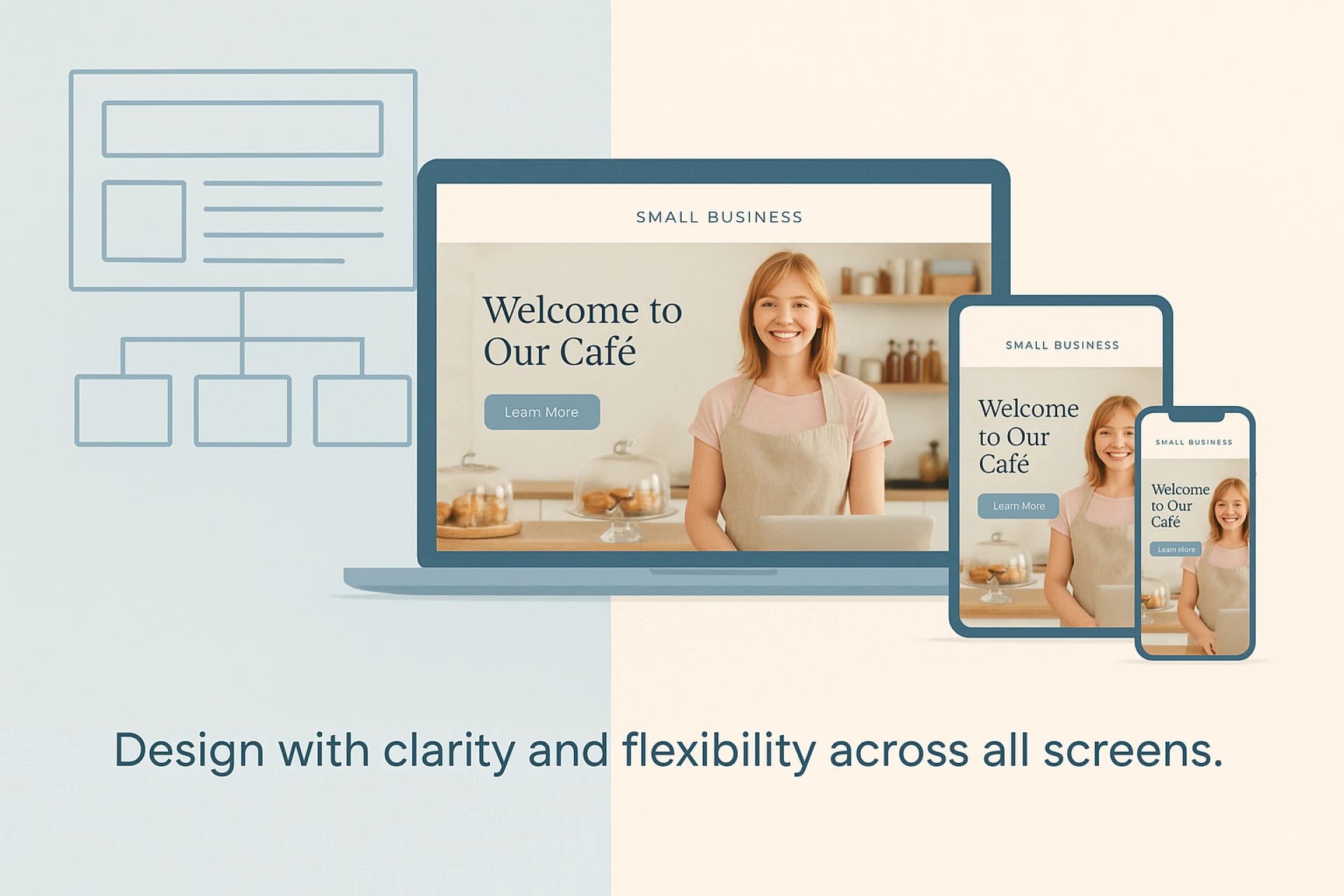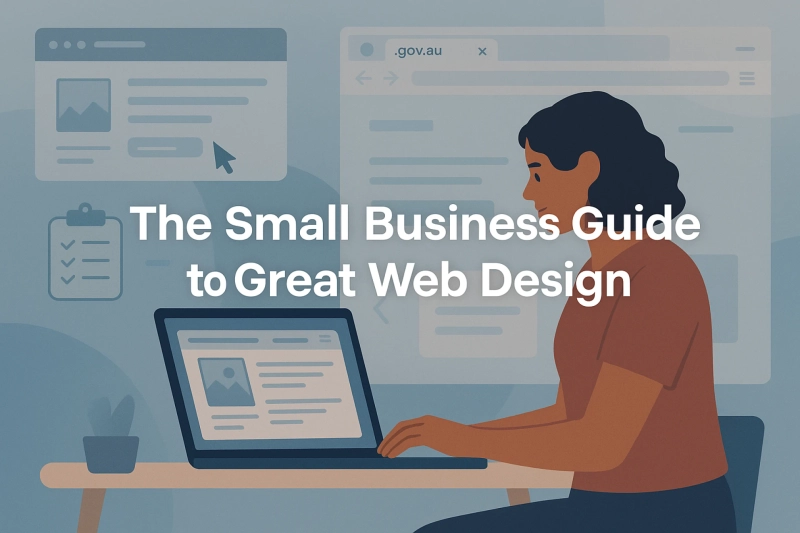Your website is often your customer’s first experience with your business, especially if you're a smaller operation trying to stand out in a crowded market. That’s why small business website design plays such a crucial role in how people perceive and interact with your brand. But building a great site isn’t about flashy features or over-the-top visuals. It’s about creating something clear, trustworthy, and genuinely useful.
I’ve worked with everything from boutique cafes to independent mechanics, and the one thing they’ve all had in common? A strong site made a noticeable difference. So, whether you're launching something new or trying to fix an outdated layout, this guide is here to help you build a web presence that actually works.
Let’s walk through what matters most — from design essentials to structure and everything in between.
Why your web structure shapes user experience
Your homepage is only part of the story. A smart website structure keeps visitors engaged, reduces confusion, and nudges people toward action. It’s not just about having all the right pages — it’s about making them easy to find.
Before diving into design, start with the practical: what pages does your business actually need? And what journey do you want people to take?
Here’s a simple layout I often recommend for small businesses:
- Homepage: Introduce your value and key services
- About page: Share your background and values
- Services: One page per core offering, for clarity
- Contact: Clear form and contact details
- FAQ or Resources: Useful if your offering is technical or time-sensitive
I’ve seen the difference a well-planned structure can make. One client — a local landscaping service — cut their email queries in half just by adding a properly labelled services page. Users could find what they needed without asking.
Build on solid business foundations first
A strong site starts with a clear understanding of your business structure. This might seem unrelated to web design at first, but it's actually a big deal. Your site needs to reflect how your business operates behind the scenes — whether you're a sole trader, partnership, or company.
This matters for things like:
- Business name consistency
- Legal disclaimers or ABNs
- How services are listed and explained
- Contact pathways (direct lines vs teams)
If you’re just starting out, or even if you're reworking things, it's worth reviewing the official Australian guidelines for digital business support and structure definitions. The clearer your foundation, the more focused your website becomes.
What makes a homepage truly effective?
The homepage is where most users land — and where most sites lose them. You’ve got a small window to tell visitors who you are, what you offer, and what to do next. That’s a lot of work for one page.
From what I’ve seen, the best homepages don’t try to do everything. Instead, they guide users quickly to what they need.
Here’s what helps:
- A clear headline that explains your core service
- Brief intro paragraph (not an essay)
- Top services or categories visible above the fold
- One strong call to action (book, contact, browse, etc.)
- Trust elements like reviews, badges, or affiliations
One local florist I worked with swapped out her homepage’s slideshow for a simple, single image and a short message. Within a week, her average time on page went up by 38%.
Design features that actually help your users
It’s easy to get caught up in the visual side of web design. But great sites are rarely built on looks alone. They earn trust through structure, usability, and clarity.
Here are some features that small businesses often overlook — but shouldn't:
- Mobile responsiveness: Your site needs to work on all devices, not just laptops
- Page load speed: Slow sites lose visitors fast
- Easy navigation: Menu bars, internal links, and search bars help users explore
- Accessible fonts and contrast: Not everyone has perfect vision
- Real images: Actual photos build more trust than stock pictures
When I helped a team of tradies redesign their homepage with these features in mind, their call volume stayed steady, but their time on site doubled. People were actually reading, not just clicking and bouncing.
Why responsive design can transform your reach
Let’s talk about mobile use — because it’s no longer optional. If your website doesn’t adapt to different screen sizes, it’s not just falling behind; it’s actively turning visitors away. Responsive design isn’t a nice-to-have anymore; it’s a baseline expectation. Whether someone’s on a phone, tablet, or desktop, your content should automatically adjust to fit — cleanly and clearly.
A deeper breakdown of the benefits of responsive web design includes:
- Better user experience across all devices
- Lower bounce rates due to consistent layouts
- Improved search engine visibility
- Easier long-term maintenance (you don’t need a separate mobile site)
It’s one of the simplest upgrades with the biggest impact, especially for businesses that rely on local foot traffic, online bookings, or product sales.
Content that builds trust (and keeps users engaged)
It’s not just about layout — it’s about what you say. Content is what builds trust, answers questions, and moves people from curious to committed.
Too many small business websites bury key info in vague, jargon-heavy blocks of text. But customers want clarity. They want personality. They want to know if you get them.
What works best?
- Conversational tone: Talk like a real human
- Short paragraphs: Break up long walls of text
- Client-focused messaging: Frame your services as solutions
- Answers to common questions: Pre-empt objections or hesitations
I once rewrote a local electrician’s services page to include real-world examples, plain English, and short Q&As. It didn’t just read better — it ranked better too.
How to find a web designer who gets your business
Once you’ve mapped your structure and defined your design needs, the next question becomes: who’s building this?
Hiring the right web designer is about more than just portfolios. You want someone who understands your business goals, not just how to make something look good.
Here are a few qualities to look for:
- Clear communication – Can they explain their process in plain terms?
- Real-world examples – Do they have experience with similar industries?
- Flexible support – Can they update or maintain your site long-term?
- Strategic thinking – Are they focused on usability, not just visuals?
If you're new to this process, check out this practical overview on how to choose a web design company. It’s a solid way to avoid headaches down the track.

Final thoughts: Build with intention, grow with clarity
Designing a site for your small business isn’t about checking boxes or adding every possible feature. It’s about knowing what matters to your users — and building around that.
When your website reflects the way your business actually works, it becomes a tool that builds trust, answers questions, and encourages action, not through flashy tricks, but through smart, thoughtful design choices.
No need to overthink it. Start simple, stay clear, and keep your audience in mind. A great small business website isn’t made overnight, but it’s absolutely within reach.


